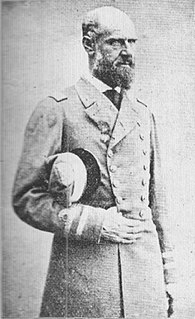
USS Katahdin was a Unadilla-class gunboat built for the U.S. Navy during the American Civil War.
The Second Battle of Sabine Pass took place on September 8, 1863, the result of a failed Union Army attempt to invade the Confederate state of Texas during the American Civil War. It has often been credited as the most one-sided Confederate victory during the War.
Edward Lea, was an officer in the United States Navy during the American Civil War. He was mortally wounded at the Battle of Galveston and died in the arms of his father, who was on the opposing side in the conflict.

USS Sciota was a Unadilla-class gunboat built on behalf of the United States Navy for service during the Civil War. She was outfitted as a gunboat, with both a 20-pounder rifle for horizontal firing, and two howitzers for shore bombardment, and assigned to the Union blockade of the waterways of the Confederate States of America.

Harriet Lane was a revenue cutter of the United States Revenue Cutter Service and, on the outbreak of the American Civil War, a ship of the United States Navy and later Confederate States Navy. The craft was named after the niece of senator and later United States President, James Buchanan; during his presidency, she acted as First Lady. The cutter was christened and entered the water for the Revenue Service in 1859 out of New York City, and saw action during the Civil War at Fort Sumter, New Orleans, Galveston, Texas, and Virginia Point. The Confederates captured her in 1863, whereupon she was converted to mercantile service. Union forces recaptured her at the end of war. The US Navy declared her unfit for service and sold her. New owners out of Philadelphia renamed her Elliot Ritchie.. Her crew abandoned her at sea in 1881.
USS Westfield was a sidewheel steam ferryboat in the United States Navy during the American Civil War.

The Battle of Galveston was a naval and land battle of the American Civil War, when Confederate forces under Major Gen. John B. Magruder expelled occupying Union troops from the city of Galveston, Texas on January 1, 1863.

The Houston Ship Channel, in Houston, Texas, is part of the Port of Houston, one of the busiest seaports in the world. The channel is the conduit for ocean-going vessels between Houston-area terminals and the Gulf of Mexico, and it serves an increasing volume of inland barge traffic.

Joseph Nicholson Barney was a career United States Navy officer (1835–1861) who served in the Confederate States Navy in the American Civil War (1861–1865).

Thomas Green was an American soldier and lawyer, who took part in the Texan Revolution of 1835–36, serving under Sam Houston, who rewarded him with a land grant. Green was clerk of the Texas Supreme Court until the outbreak of the Civil War, when he became a Confederate cavalry leader. After winning several victories, including the Battle of Valverde and the recapture of Galveston, he was promoted brigadier and assigned command of the cavalry division of the Trans-Mississippi Department. In the Red River Campaign, he was mortally wounded while charging a fleet of Federal gunboats. The Union naval commander David Dixon Porter paid tribute to Green as a serious loss to the Confederacy.

USS Owasco was a Unadilla-class gunboat built for the Union Navy during the American Civil War. She was named for Owasco Lake.
The second Navy vessel to bear the name Sachem, this screw steamer was built in 1844 at New York City, where it was purchased by the Navy on 20 September 1861.
C.S. Army Tug Neptune was a wooden tugboat taken over by the Confederate States Army in about 1862 for the Texas Marine Department. She was employed as a tug, transport, and lookout vessel in the vicinity of Galveston, Texas.
USS Rachel Seaman was a wooden schooner purchased by the Union Navy during the American Civil War.

The Battle of Galveston Harbor was a naval engagement between forces from the Union Navy and the Confederate States of America in the American Civil War. It was fought on October 4, 1862.

Little Rebel was a cotton-clad ram that had been converted from a Mississippi River steamer to serve as the flagship of the Confederate River Defense Fleet in the American Civil War. Sent from New Orleans to defend against the Federal descent of the Mississippi, she was among the force that engaged vessels of the Union Army's Western Gunboat Flotilla at the Battle of Plum Point Bend on May 10, 1862. On June 6, she again was involved in an action with the Federal gunboats, this time at the Battle of Memphis. In the battle, a shot from a Federal gun pierced her boiler, disabling her, and she was then pushed aground by the Federal ram USS Monarch and captured.

USS Kinsman, sometimes called USS Colonel Kinsman, was a sidewheel steamer captured by the Union Army during the American Civil War. She was used by the Army and then by the Union Navy as a gunboat in support of the Union Navy blockade of Confederate waterways. On 23 February 1863, she hit a snag and sank.
The Texas Marine Department (1861–1865) was formed in the State of Texas shortly after Texas came under blockade from the Union Navy in 1861. It operated under the control of the Confederate Army during the Civil War.

Leon Smith was an American steamboat captain and soldier. In the American Civil War he served the Confederate States of America as a volunteer; he was named Commander of the Texas Marine Department under General John B. Magruder. Smith was involved in most major conflicts along the Texas coast during the war, and was described by war-time governor of Texas Francis Lubbock as "undoubtedly the ablest Confederate naval commander in the Gulf waters".











